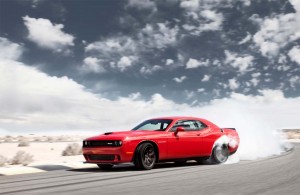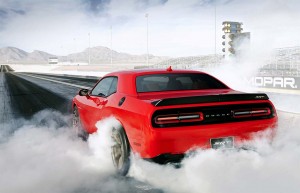
The 2015 Dodge Challenger SRT Hellcat and its 707 horsepower posted a stunning highway mileage figure of 22 mpg.
In the “golden age” of muscle cars, models like the Dodge Challenger were lucky to come close to delivering double-digit fuel economy. So, the EPA’s official mileage numbers for the new Dodge Challenger SRT Hellcat could come as a shock.
Equipped with a six-speed manual gearbox, the 707-horsepower coupe – the most powerful muscle car ever to emerge from a Detroit factory – will delivers 21 mpg on the highway, the EPA giving it a less surprising 13 mpg city rating, with the combined figure at 16 miles per gallon. Surprisingly, the automatic gets 22 mpg on the highway, which is due to the highly efficient eight-speed transmission.
The numbers underscore the pressure automakers are under as U.S. and overseas fuel economy numbers are ratcheted ever higher, but also show how new technologies, such as direct injection and supercharging can yield significant benefits in both performance and mileage.
Dodge is clearly hoping that the 22 mpg rating will increase the already significant buzz the Hellcat has generated since its unveiling earlier this year. The fuel economy numbers appear to be well beyond initial expectations – even as the coupe’s 707-hp rating far exceeds the maker’s originally estimate.
And, if anything, recent reports have suggested the Chrysler division could soon find room to bump the figure even higher, perhaps to as much as 800-hp – though there are also indications that the current version, using the supercharged 6.2-liter Hemi V-8, may be having trouble meeting federal emissions regulations.

Driving the 707-hp Dodge Challenger SRT Hellcat like this won't get the driver 22 mpg on highway or the 16 mpg combined rating announced by the maker today.
Derek Lindsay, a powertrain analyst for Southfield, Michigan-based IHS Automotive, said there is little doubt the Hellcat has captured the interest of magazine readers and automotive enthusiasts who can’t seem to get enough information about the car and its big Hemi.
“It’s a lot of fun to talk about,” he noted during a discussion with journalists, even though it won’t necessarily alter the industry’s path towards smaller, lighter engines and greater electrification of powertrains.
(Future versions of the Ford Mustang could adopt downsized engines, advanced turbos, even hybrid alternatives. Click Here for the exclusive report.)
Despite the current push for cleaner, more fuel-efficient engines, automakers around the world have been racing to up the performance ante. There are a handful of models that can top the Hellcat, but they are high-priced exotics, such as the Bugatti Veyron and Koenigsegg Agera One:1. And they typically fall far short of the Dodge Hellcat’s fuel economy.
The highway mileage for the $424,825, 700-hp Lamborghini Aventador Roadster is a more modest 18 mpg, the same as the less powerful $287,820 Aston Marton Vanquish.
(Click Here for details about how German brands may capitalize on China’s lack of brand loyalty.)
Tim Kuniskis, president and CEO, Dodge and SRT Brands, described the official fuel-economy rating as compelling proof of Dodge’s ability to deliver an affordable supercar.
“The fastest muscle car ever, the Challenger Hellcat can run 10-second ETs at the track, and then get 22 miles per gallon on the drive home,” he said. “With a starting price of $59,995, there’s nothing else that even comes close.”
(To see more about Nissan’s new “shop truck” for its engineering team in Arizona, Click Here.)
Dodge officials note that many of the same enhancements that help churn out all that horsepower also pay off on the fuel economy side of the spec sheet. That includes such modifications as the forged-steel crankshaft and, for those who prefer not to work a stick, the Hellcat’s optional 8-speed automatic. The muscle car also gets cylinder activation, which shuts off half of its cylinders when power demands are light, as is typical on the highway.
Also known as “displacement-on-demand,” it’s one of a number of new technologies that industry experts expect to see used commonly on muscle and performance cars in the years ahead.
(Paul A. Eisenstein contributed to this report.)

With the outrageous current fuel prices the oil Cartel/Cabal is charging, car makers must provide decent mpg for muscle cars or hurt their sales.
There was a guy who bought machines like this for fuel economy, in Utah I think, but they finally found the right medications for him and he quit. Which doesn’t change the fact it is a pretty cool thing getting this kind of mileage out of that kind of car. Wild-guessing, I figure a steep overdrive ratio, below .70, and at 55 mph it’s likely running on 4-cylinders with a rpm in the neighborhood of a bright kid’s SAT score (new edition). Nice job.